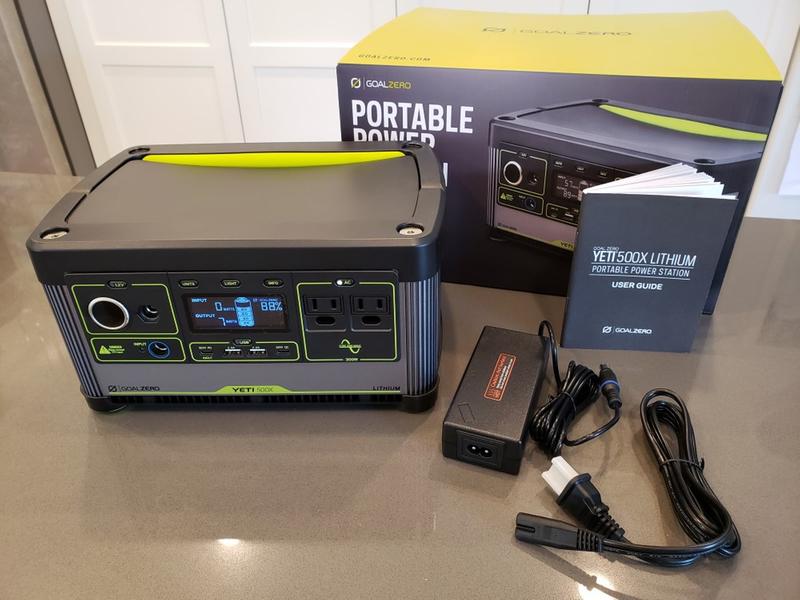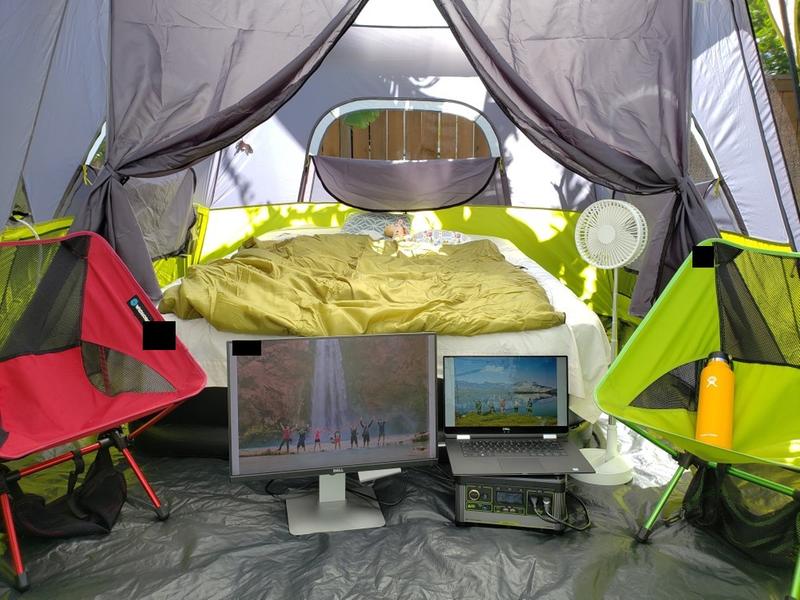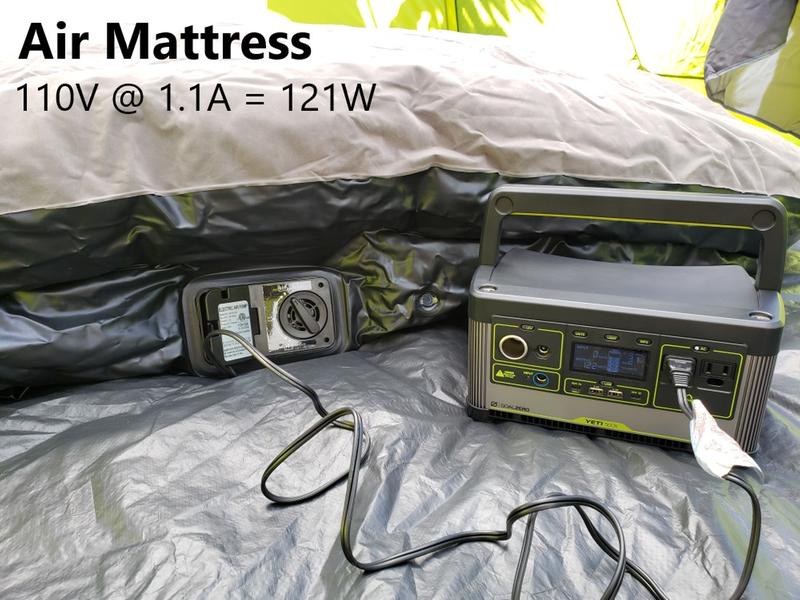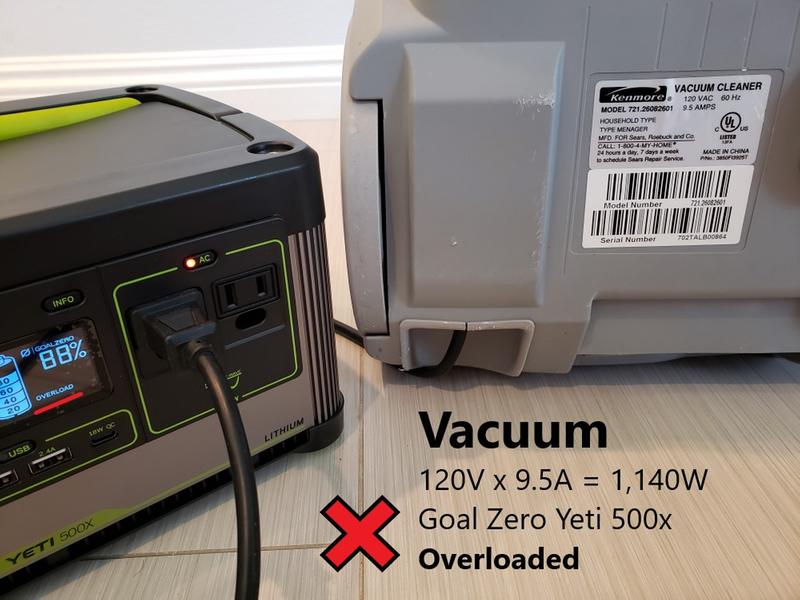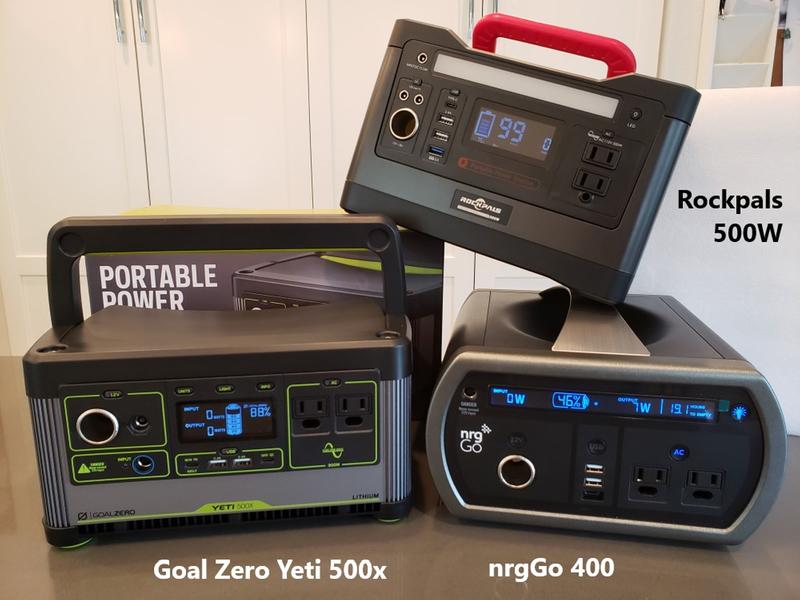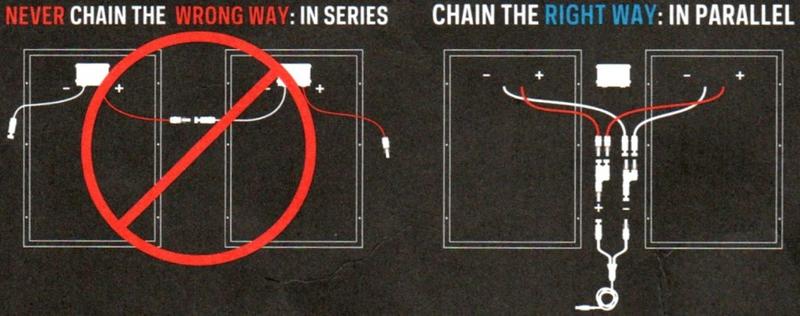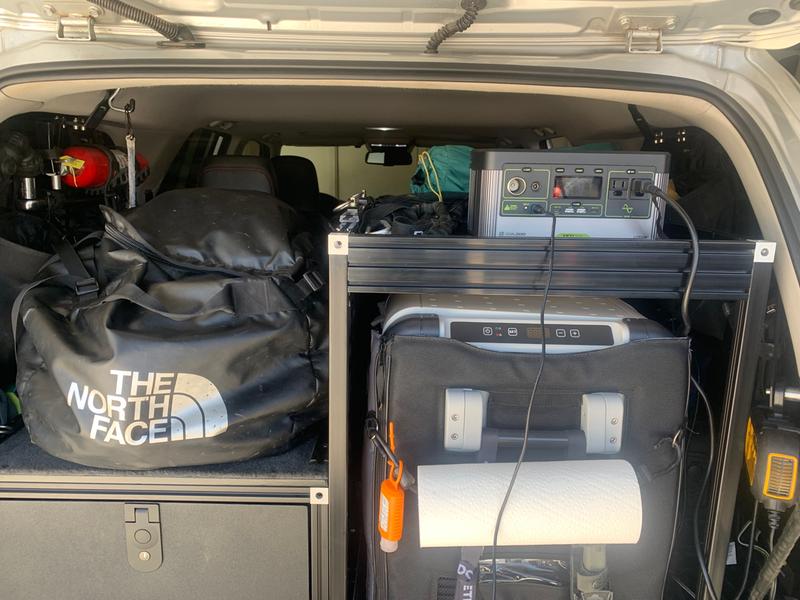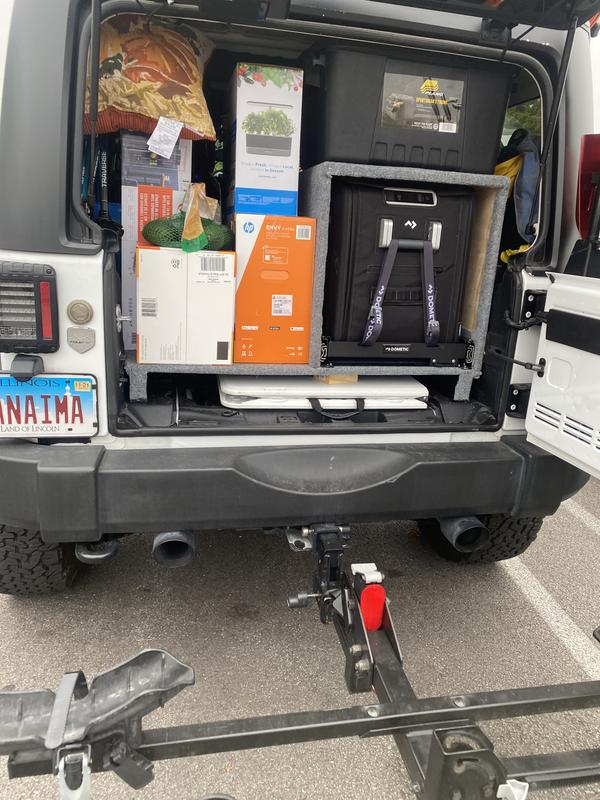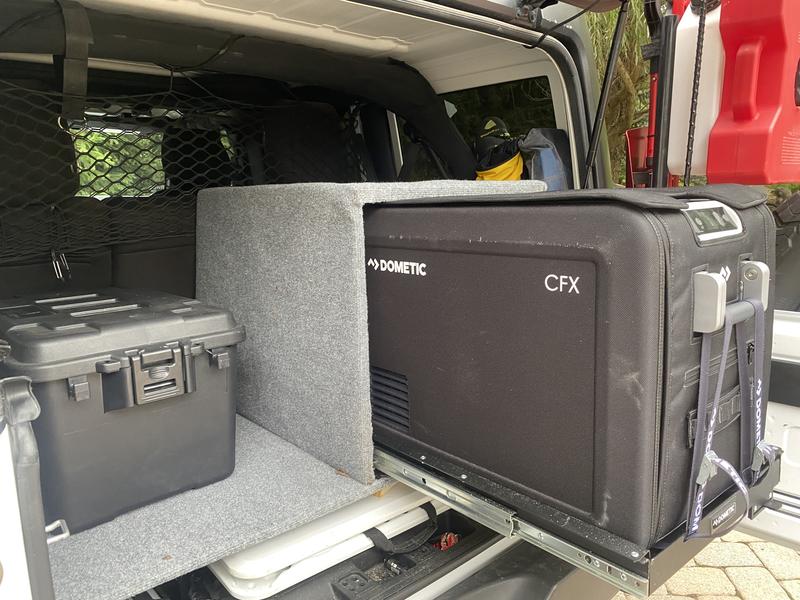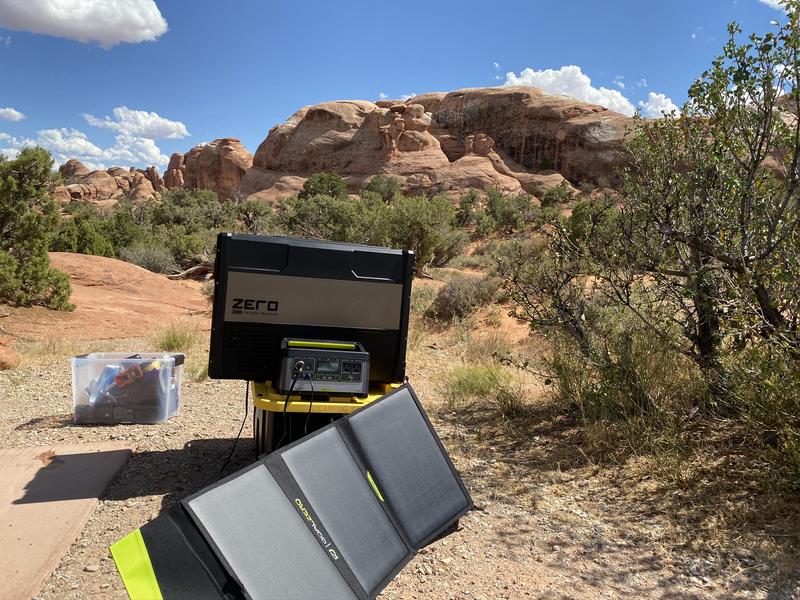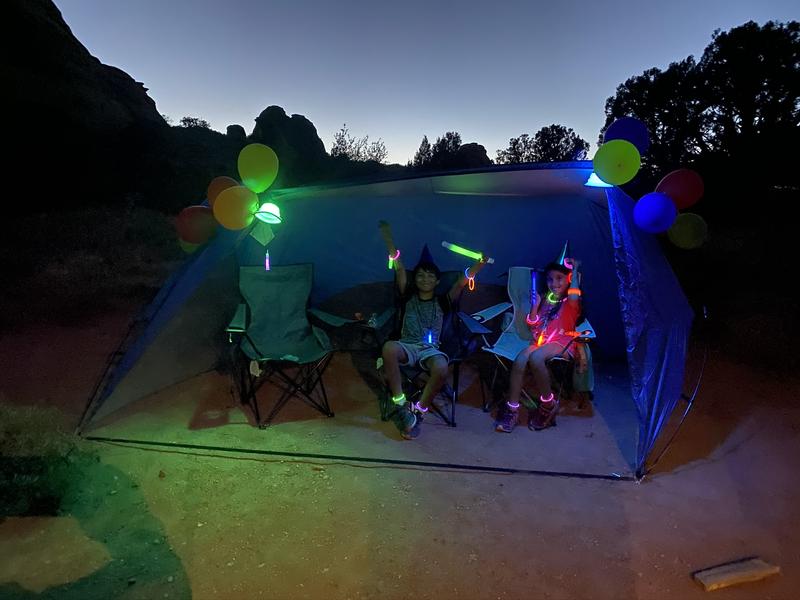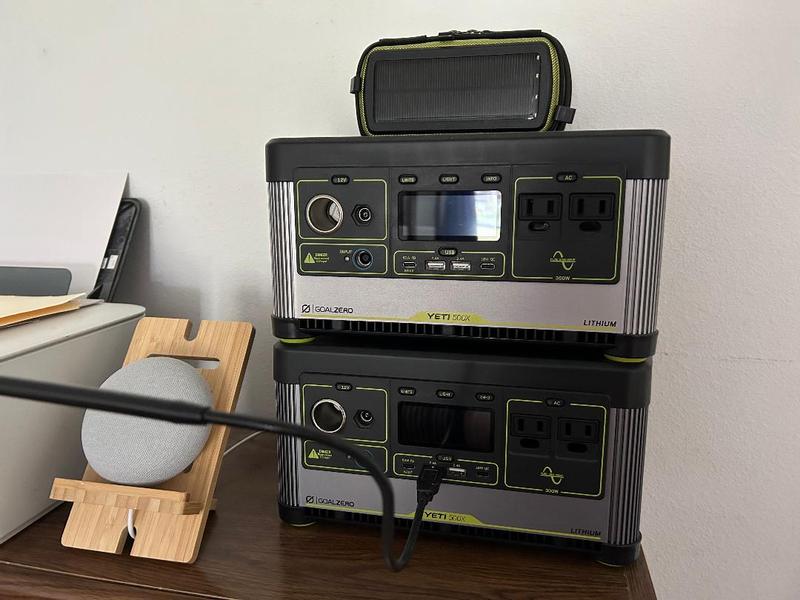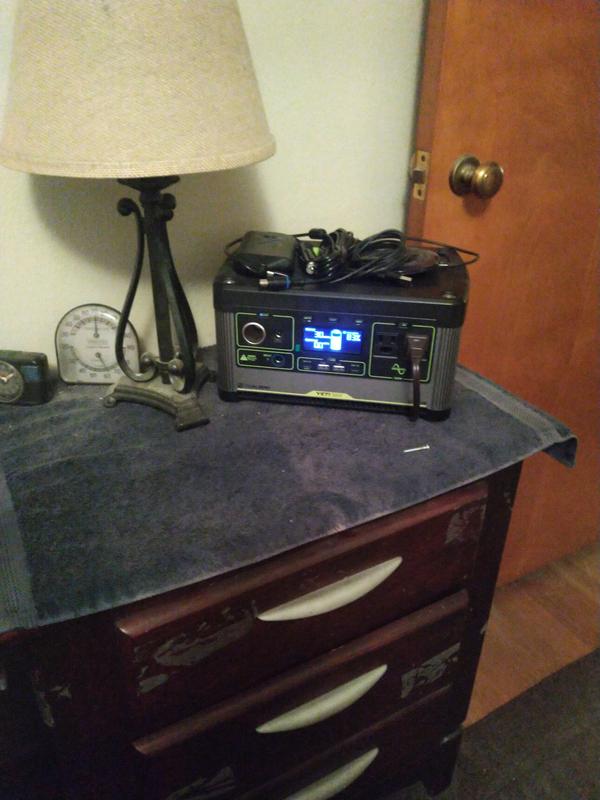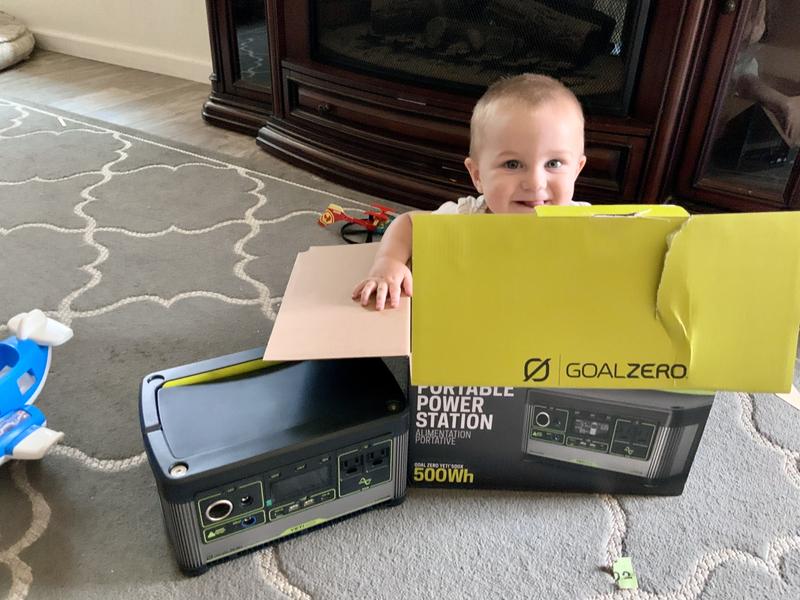Goal Zero Yeti 500X Portable Power Station
Complete your overlanding rig or prep for extended camping trips with the Goal Zero Yeti 500X power station. Its 505 watt hours pack a punch, with more than double the capacity of the Yeti 200X.
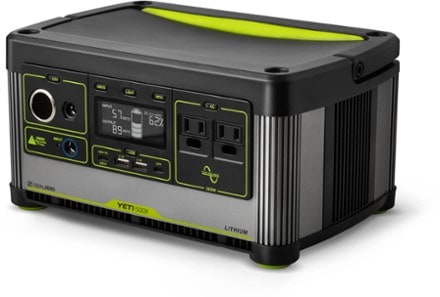



This item pays for membership!
$49
10% Reward
on this and every eligible full-price item*
+
$30
Bonus Card
valid for 30 days after joining*
=
$79
Value
Keep shopping
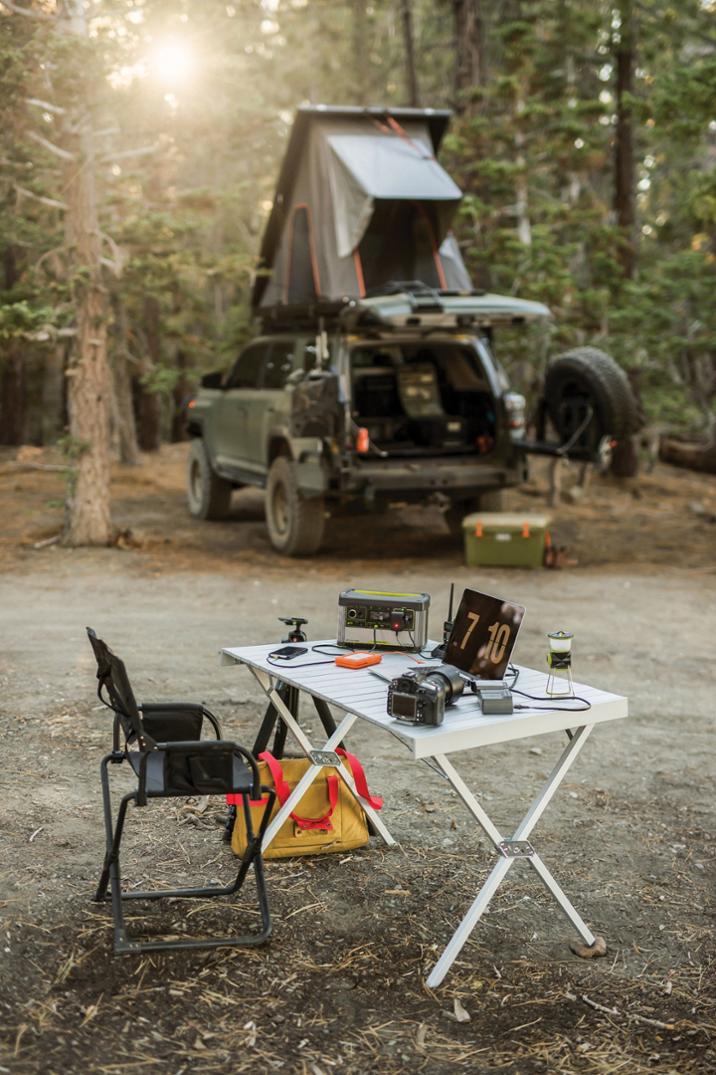

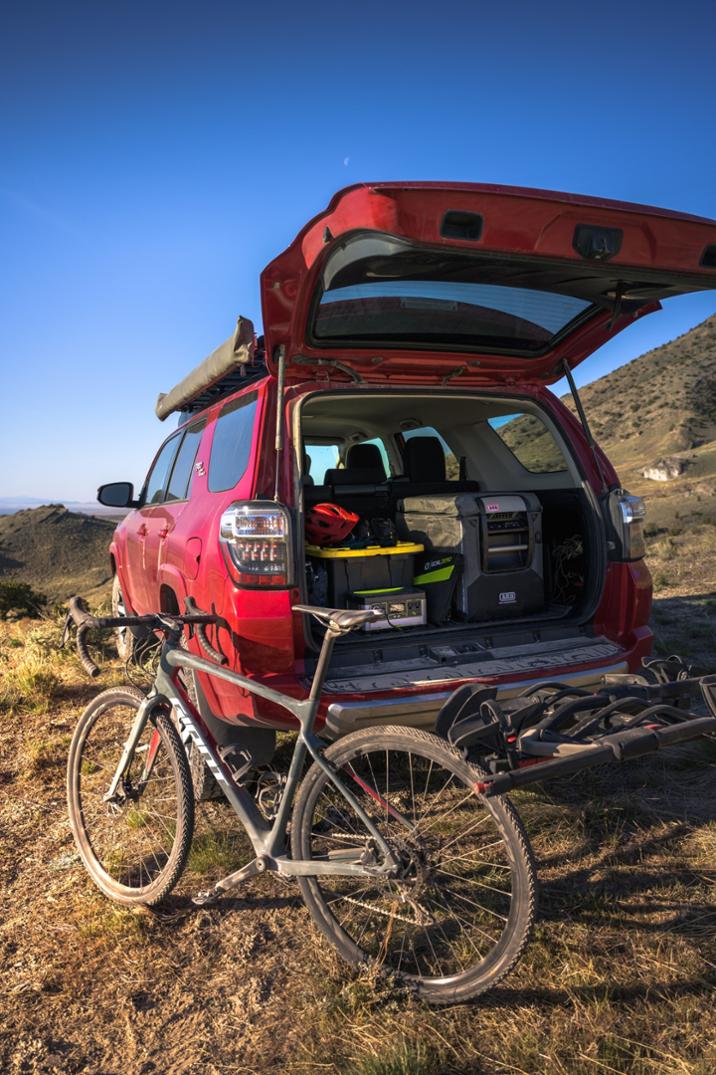






- 4 different port options—including AC, 12V, and 60W USB-C PD—power a wide range of devices, from phones to portable fridges
- Equipped with a high-speed Power Delivery port capable of charging USB-C laptops, tablets, mirrorless cameras and phones in a fraction of the time
- 3 ways to charge: from the sun, the wall or the car
- Recharge while off the grid with compatible Goal Zero solar panels like the Nomad or Boulder (not included)—the higher the watts of the panel, the faster the charging time
- Get the best solar charge (6–12 hours charge) for this power station with the Boulder 100 Briefcase or Nomad 100
- Featured MPPT charge controller ensures you're getting the most efficient solar charge possible
- Plug it into the wall to fully recharge in 10 hrs. using included 60W power supply—or plug in with the Yeti X 120W Power Supply (not included) to halve that charge time
- You can also use any USB-C power supply to charge the power station
- Plug into your vehicle's 12V outlet using the Goal Zero Yeti Lithium 12V Car Charging Cable (not included)
Imported.
View the Goal Zero Yeti Product LineView all Goal Zero Portable Power Stations| Charge Time (hrs) | USB-C: 8-11 hrs.; wall: 9 hrs. |
|---|---|
| Battery Included | Yes |
| Material(s) | ABS plastic/aluminum |
| Best Use | Camping |
| Battery Capacity (Wh) | 505 watt hours |
| Dimensions | 11.2 x 7.5 x 6 inches |
| Power Output to Device | USB-A: 5V up to 2.4A (12W max) / USB-C PD: 1 at 18W max, 1 at 60W max / 6mm Port:12V, up to 10A (120W max) / 12V Car Port (output), 12V up to 10A (120 max) regulated / 120V AC Inverter: 120V AC 60Hz, |
| Solar Compatible | Yes |
| Battery Type | Lithium Ion |
| Weight | 12 lbs. 14.4 oz. |
| External Charge | Car / USB / Wall |
Write a Review
Adding a review will require a valid email for verification
Customer Images
Most Helpful Favorable Review
Most Helpful Critical Review
Excellent quality but low 300W continuous output
The GZ Yeti 500x really surprised me. Pricing aside, I came to appreciate the design and engineering that went into it. It is a beautiful, tough (and tough-looking), relatively lightweight power station that dethroned my former 500Wh favorite for its compact size: the Rockpals 500W. The Yeti 500x somehow manages to be even smaller while staying true to the company's infamous safety mantra: top-tier LG battery cells, high-quality BMS, Pure-Sine Wave AC output for sensitive electronics, and unmatched 1200W surge output. Marry that with a healthy, extensive ecosystem of products and accessories, and you can scale out the system as large or small as needed for a variety of uses. The 8mm 120W (front OR back) and USB-C PD 60W ports can be used at the same time with the MPPT controller to charge the Yeti even faster at 180W. For an industry leader, however, there are some things I do not like, such as the continuous output being set at 300W when competitors in its class are 500W. GZ's products also go for a price premium, yet do not have accessories (like cables) included. Overall, I am in love with the way the power station looks and how compact it is. Some thoughtful design was put into the product with top-notch components, and if GZ had bumped the continuous output to match the competition at 500W, the Yeti 500x -- along with the safety reputation the company has been known for -- would have been hard to beat. PROS - Li-ion cells made by LG (a top-notch, Tier 1 battery manufacturer) - Very professional, tough look with a pleasing color scheme -- Aluminum exterior helps protect against bumps and battery puncture --- Given that Li-Ion batteries become more volatile as capacity increases, this added protection important --- Environmentally friendlier than hard plastic -- Vertical, rounded edge grilles provide extra grip, heat dissipation, and act like phone case bumpers --- Rounded corners are less likely to shatter than sharp edges -- Jackery, Rockpals, and other brands I have tried were made of hard plastic shells that may be more prone to cracking and overheating -- Brushless fan on each side with front-bottom vent for cooling - MOST compact 505Wh power station I have seen (11.25" x 7.5" x 5.8") -- Relatively lightweight at 13 lbs with aluminum exterior --- Rockpals 500W: still lighter with its plastic shell at 12.13 lbs --- Yeti 400 Lithium: 16.3 lbs -- Roughly equivalent to a 136,487 mAh 3.7V power bank (or 46,759 mAh 10.8V) -- Capacity to power a 30" LCD monitor and Mini PC for 5-7 hours, a Toshiba 50" Fire TV for almost 4.5 hours - Pure-Sine Wave AC Inverter capable of continuous 300W power (and unmatched 1,200W peak) -- See USAGE section -- Clean power for sensitive electronics -- Less heat -- Note: Some manufacturers claim to be Pure-Sine when they are actually Modified or Square Waves - High-quality BMS for safety -- Provides built-in overload, overcharge (automatic stop when the device is full), and short-circuit protection - Regulated Input and Output ports - Can power AC and DC (USB/12V Car adapter) at the same time (as long as they draw less than 300W combined) -- Laptop, tablet, phone, light, fan, CPAP medical device, projector, TV, mini refrigerator, speaker, camera, and SOME rice cookers - Faster charging with MPPT controller (Maximum Power Point Tracking). Older Yeti 400 Li uses PWM -- Two input options: 120W 8mm port (front OR back) and/or USB-C PD 60W --- Both can concurrently charge for 180W total! (Jackery Explorer 500 maxes at 100W) ---- Can parallel-connect multiple solar panels for faster charging with a Y-branch cable (not included) -- Can be used while charging -- USB-C PD is powerful enough to charge a 60W laptop (ie. 13" MacBook Pro) - Foldable handle with a comfortable, non-slip grip -- Top of Yeti 500x is concave to help keep small items from getting lost. Nicely done! - Excellent, informative LCD with LED backlight -- Total power coming in -- Capacity left (as a percentage) -- Total power being used -- Estimated hours --- When Input > Output, shows time to full --- When Output > Input, shows time to empty -- Units can be toggled between "Volts" and for Output: "Amps", "Watts", "Watt-hours" - Bottom is well-protected by neon green, non-slip feet - Manual: Unusually detailed with some helpful tips - Great technical support - Good customer service - Large ecosystem of accessories and interoperable products - 2 year warranty - American company founded with humanitarian goals CONS - Continuous output is only 300W when most competitors are 500W -- Most people likely do not use more than 300W, but having it this low limits the number of devices you can plug in at the same time --- Yeti 500x was capable of sustaining a test 350W output. Although it could do that, going over 300W for long can shorten the battery's life over time -- Its BIG advantage over others is the 1200W surge output -- See USAGE section - Display: LCD is unreadable without LED backlight - No QuickCharge 3.0 USB output for rapid charging of compatible devices - Could be considered heavy by some due to the use of aluminum housing instead of plastic - No built-in light to illuminate your walking path (or area) or blink "S.O.S." - Automatic shutoff when idle is an unusually long 30 hours -- Ensures Yeti does not turn off when a low-powered device (like medical CPAP) is used overnight -- Could unexpectedly drain battery from 100% to 40% with nothing connected (because AC inverter uses 7W on its own) -- Power buttons can be accidentally turned on/off with a short press (ie. while packing away your camping gear) -- Jackery Explorer 1000 & 500: 12 hrs. Rockpals 500W: 10 hrs - Multiple fans turn on during high peak and can be too noisy for some - Premium pricing - No cable accessories or carry bag included besides the 57W wall charger (takes 100-240V input) - Cannot be chained to other Yetis to extend capacity - Battery not replaceable -- Leads to landfill/environmental waste. Please recycle responsibly! - Not waterproof. Keep it away from water splashes, rain, and pool! -- Lithium and fire or water can cause serious damage or injury! CONTINUOUS VS PEAK OUTPUT - Yeti 500x's AC Inverter provides a continuous output of 300W with an impressive peak/surge of 1,200W -- AC Inverter: Component responsible for converting battery (DC) power into AC for use by electronics - Continuous Output: As long as a device (or combination of multiple ones) does not exceed 300W, it can be used -- A TV that uses 100W can be used because it is less than 300W. You can add more devices as long as they do not exceed 300W combined -- A miter saw I have uses 1,800W, and because it exceeds 300W, it cannot be used - Peak/Surge: Almost every device temporarily draws more power when it is turned on. The highest amount it pulls during that time is the Peak/Surge. This Yeti can accept up to a 1,200W! -- A TV that uses 200W (continuous) may temporarily suck up 700W (peak) when powered on. Because 700W is less than 1,200W (peak), this battery will allow the TV to turn on at that level for a few seconds (any longer, and it might cut power as a safety precaution). After a few seconds, the TV then only uses 200W (less than the continuous 300W limit) until the battery is drained -- An unusual device that uses 250W (continuous) and surges to 1,500W when powered on would instantly be shut off by the Yeti. Why? Even though the device uses just 250W while already on, it jumps to 1,500W when powered on, exceeding the 1,200W surge limit of the Yeti Some devices power on at a higher (Peak) wattage than when they are already on (Continuous). As a result, the power station may not be able to start it CALCULATIONS The below calculations are rough estimates as conditions, quality, and product age can vary. CHARGING TIMES - 3 hrs at max input of 180W (120W via 8mm, 60W via USB-C PD) - Wall charger: 8.5 hrs at 60W - Car charger: 4.5 hrs at 120W - 100W solar panel: 6-12 hrs, depending on weather condition and panel efficiency -- With two 100W panels, charging can be doubled -- WARNING: do NOT connect panels sequentially or you may output too much voltage and fry the power station! Connect them in PARALLEL with a Y-Branch cable HOW MANY WATTS DOES A DEVICE US? - Calc: Watts used by device = Voltage x Amperage - If a vacuum is 120V and 9.5A, it uses 1,140W If a device draws more than 300W for an extended period of time, the power station will shut off as a safety precaution. This can also shorten the battery's lifetime HOW LONG CAN A DEVICE BE USED FOR? - Calc: Hours available for device = Battery capacity (Wh) x 0.85 / Watts used by device -- Generally, about 10-15% of power is lost during power conversion - If a device uses 60W, it could last up to 7.2 hours (505 Wh x 0.85 / 60W) HOW LONG DOES IT TAKE TO CHARGE A DEVICE? - Calc: Hours to charge device = Device's battery capacity (Wh) / Input Wattage - If a laptop accepts 60W of input and its battery capacity is 550 Wh, it could take 9.2 hrs to charge (550 Wh / 60W) HOW LONG DOES IT TAKE TO CHARGE THE YETI 500X WITH SOLAR? - Calc: Hours to charge battery = Battery capacity (Wh) / (Panel Wattage x [0.5 or 0.75]) -- In a perfect lab environment, solar panels charge at the indicated wattage (ie. 150W) -- Expect to only receive 50-75% on a good, sunny day (ie. 75W - 113W), depending on environmental conditions, panel's age, and component quality -- Tip: Even if it is overcast, the panels will STILL collect solar energy. Keep charging! - If a solar panel is rated for 100W, it could take as fast as 6.7 hours [505 Wh / (100W x 0.75)] to charge HOW DOES ITS CAPACITY COMPARE TO POWER BANKS? - Calc: Powerbank-equivalent capacity (mAh) = Battery capacity (Wh) / Voltage x 1000 -- 1 Ah = 1000 mAh - Yeti's 505Wh at 3.7V is roughly a 136,487 mAh powerbank (505 Wh / 3.7V x 1000) or a 46,759 mAh at 10.8V
Overlanding
The size is perfect for my overland trip it charges fast and keep my cameras and drone batteries plus laptop plus dometic fridge running all day and night long when I am running suit a 100 watts solar panel
Several Issues
I have now had two different units both have failures within 24hrs of receiving. The first unit would not put power out the 60W USB-C from day one. Exchanged for a different unit at REI. The second unit had the same issue and while going through the reset process with Goal Zero support, the second unit is completely dead. Definitely a bummer as the 500X has features that competitors do not offer. I will be taking it back to REI and most likely ordering a competitor to GZ (Jackery, Rockpals. etc). It's too bad REI only carries Goal Zero or I would make my purchase from REI. REI's customer service and support has been the only shining light in this experience.
Awesome idea on paper
I am really glad I bought this through REI. The only redeeming factor of this unit was the customer service the retailer provided. I went through two of these batteries within a month due to the battery suddenly become incapable of accepting a charge from either solar or AC. I only got to use each battery a few times in my house while I was testing out different loads (all under 150 watts, well within the rated amount) while using goal zero panels to charge the unit (nomad 50). When I contacted Goal Zero (after a 40 minute hold) they informed me it would be well over 4 weeks to see my battery again. REI accepted my return without question. Do not buy this battery, there are better options out there.
Waiting to hear from GZ.
I was super excited to pick the new Yeti500X. It powered my Traeger ironwood 650 no problem. Then after the second charge using the included 120 power supply the unit stopped taking a charge. After 2 phones calls and waiting on hold a minimum of 30min each phone call they told me to email my info and receipt to them and they’ll get it fixed. Well it’s been a week and 2 emails 3 days apart and I haven’t heard anything from GZ. So far I’m very disappointed. For the price they charge for there products you’d think they’d have better customer care. Not happy at the moment.
Unreliable power source
I ordered this unit to use as a backup power source for emergencies at home and to use while camping. I have used Goal Zero products for several years now, including solar panels, power generators, and lights. I have had fairly good luck with their products in the past. I would hold off on this product for now. First, there are several other brands to choose from when it comes to portable power. They have similar features, at several different price points. This particular model is new, released in the spring of 2020. I received mine mid to late April. I charged it up according to the instructions, and took it on an extended 1500 mile camping trip. The second day, I used a Goal Zero solar panel to top off the battery. It charged for a few minutes and stopped. I tried to charge it using AC power using the included power cord. Still nothing. The unit never charged again. Not a big deal, it’s a new model. I was confident Goal Zero would take care of me. I made several attempts to contact Goal Zero over several days. No one would respond to me. It wasn’t until several days later that I made a negative remark about the product on their social media adds that someone finally responded. There customer service was horrible. When someone finally emailed me, they were very dismissive and rude. Personally, to buy a piece of technical equipment like this for $700 and not have customer service, it’s a deal killer. If you are interested in Goal Zero products, I highly recommend you purchase them through REI. After giving up on Goal Zero, I called REI. They immediately shipped out a replacement unit. Their customer service was extremely helpful and professional. I can’t say enough about how great my experience was dealing with them. I have received a replacement unit from REI. I am still testing it out, and will review the product again when I am more confident in its reliability. I personally would avoid purchasing a Yeti 500X until Goal Zero works the bugs out of this new unit, and until they can offer competent customer service. Until then, if you’ve got to have it, buy it from REI for your own protection and piece of mind.
Works well, but not worth the money
Goal Zero batteries are more expensive than competitive products. I don't think the added expense is worth it. The Eco Flow River product has a lower list price and more power, but that's not the whole story. The Goal Zero 500X ships with a miserly 60 watt charger that takes 10 hours to charge the battery. 10 hours! If you want a faster charger, you have to pay $40 more. How cheezy is that? And it you want a car charger, it's another upcharge. The EcoFlow River product comes with with a faster charger, the battery charger, and much better specs, and it's $50 cheaper. For $200 less than the Goal Zero, you can get a Jackery 500 with the good chargers, and the Jackery usually tops the web site reviews I've seen. I returned the Goal Zero and ordered the EcoFlow River product.
DO. NOT. BUY.
Hey- there are quite a few reviews mentioning that this product is susceptible to charging failures within a short time. This is true. I took the unit on a 10 day RV trip from CHI to CA and it failed on the 9th day. It would not accept a charge from either 110, 12v, or the Goal Zero solar panels. The company agreed to replace it, but unsure that I want to risk another unit doing the same thing and may just return it to REI.
Never got a chance to use
I charged the battery once in May and stored it in my garage for back up power. Got a notice that the power will go out this weekend so I went to get it to make sure it was ready to go. The battery level is at 58% without being used. I went to charge it and it will not charge on solar or ac power. I will be returning. I’m so disappointed. It took a lot for me to convince the wife we should do solar generators vs gas.
12 Volt Port Failed After One Month
I really wanted to love this product. I bought the Yeti 500x to power an ARB 47 QT Zero refrigerator with the 12 volt DC plug since that uses less power from the battery than the 110 volt AC plug. It worked fine for a month and then the 12 volt port failed. It never was overloaded and the ARB power draw is well within the output range of the port. I need a battery to power my ARB on long trips so I am now waiting for a replacement since REI is backordered. That being said REI customer service was great. I specifically bought this from REI because of the customer service as I have heard Goal Zero's customer service is poor and have seen lots of reviews of this particular unit failing in some way. First time Goal Zero product for me but now I am considering a Dometic battery instead. This unit has so many features if one like the 12 volt port or usb or inverter, or main board, etc. goes bad you have to deal with the return and repair.





